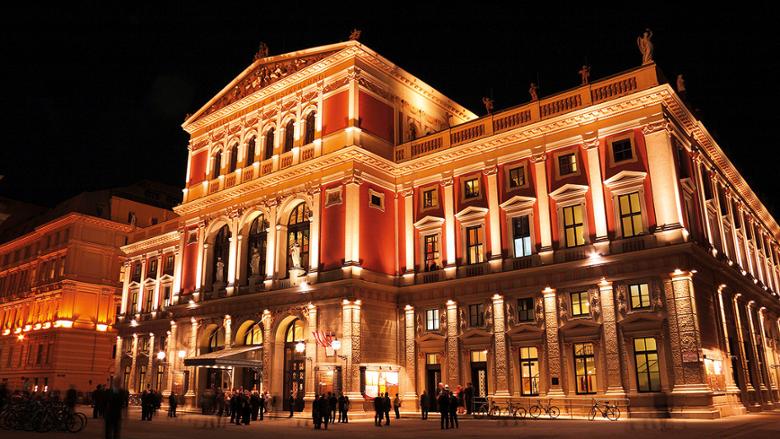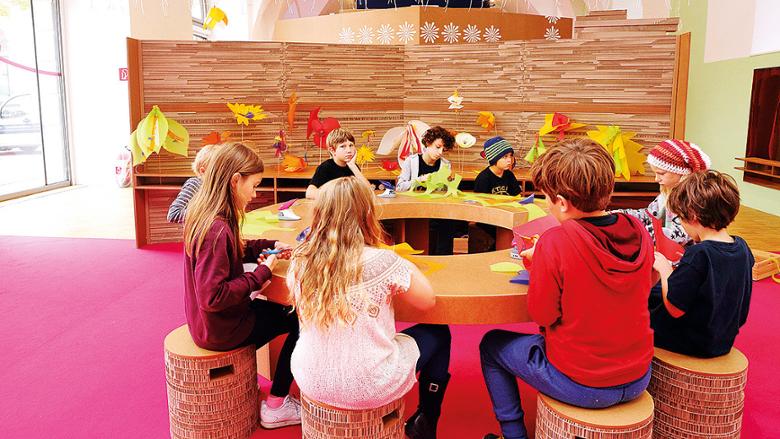
My family’s trip to Vienna was designed to correct a mistake I’d made the previous year. Aged four, my daughter, Antonia, had demanded piano lessons. She loved to sing, she said. Her favourite thing was music, she said. It would be such fun if she could sing and play at the same time, she said.
Buoyed by my husband’s enthusiasm (‘Mozart was composing by the age of five,’ he mused), I consulted my aunt Valerie, who has been a musician, teacher and performer for more than half a century. Valerie gave clear and sage advice: ‘If your child likes music, let them join a singing class. Don’t start lessons until they’re six or seven.’
I did not listen to Valerie. Nor did Father Christmas, who delivered a charming Thirties upright piano to our London flat. Antonia was ecstatic. Her joy only increased when I engaged a piano teacher. Also a choir director and composer, and in possession of a masters in teaching piano, his is a slick operation for a young music enthusiast: the engaging half-hour lesson is balanced between voice and keyboard work; Antonia was smitten and so was I.
Fast-forward a year and Antonia was five and just as enthusiastic as ever - in theory - about music. But she wasn’t practising at all. She approached her weekly pounds 30 lesson in the manner of a person passing a street performer (this is amusing; this requires no effort from me). This attitude was beginning to irk my husband. Then I thought of Mozart. The world’s most famous child prodigy may have died 226 years ago, but he’s alive and omnipresent in Vienna. I know this because I lived in the Austrian capital for half a year when I was a child, on a school exchange.
In the mid-Nineties, a few things struck me about Vienna: the hazelnut cakes were superlative; Klimt, whose work I’d never seen before, was absolutely everywhere. But most striking was this: in a city not unfamiliar with snobbishness, music was for everyone. My fellow teens - cool and otherwise - went to classical concerts for fun.
In France, children are expected to turn up at the table at mealtimes to eat - and converse - like adults. In Austria - or Vienna, at least - children of all socio-economic backgrounds have a musical literacy more advanced than most adults from elsewhere. While hardly surprising (the country’s musical heritage is unmatched), the egalitarianism of it all was infectious.
With four opera houses, endless concert halls and special balls just for estate agents, Vienna is the world’s capital of classical music; 15,000 concerts are staged there each year. Wouldn’t it be sensible, I suggested to my husband, to take Antonia and her four-year-old brother, Henry, to Vienna for a music-themed long weekend? My husband was sceptical. We’d been to - and loved - West End musicals, and free lunchtime concerts at St Martin-in-the-Fields. But this was a daunting level of commitment. In Vienna, the genius of Mozart would seep in, I argued.
The children would watch everyone from small singing boys to grown-up cellists display their artistry and skill. They would begin to appreciate the incredible amount of work that goes into being a musician. In what is regularly named the most family-friendly city in the world, my family could only gain new motivation. Foreign cities can be overwhelming for families. But pick a theme, and suddenly children and adults are on the same team, on the trail of clues that will illuminate the subject.
I scheduled a concert a day, over a five-day, four-night break, and balanced live performances with activities to blow off steam. And as you conclude that I am the pushiest mother to have held the position, I should admit that my husband feared the same. But he now lists our trip to Vienna as his favourite family holiday.
The evening we arrived, while the boys rested, Antonia and I headed to MuTh (Musik & Theater), the dedicated concert hall of the Vienna Boys’ Choir. With members as young as five, this was the perfect way to draw my daughter’s attention: children love seeing other children perform. She sat, rapt, as the boys in their sailor suits sang. The conductor ended the hour-long concert with an unusual tribute to Leonard Cohen, who had died a few days earlier, by leading the boys and the audience in a singalong Hallelujah. Cheesy but interactive: my daughter skipped out of the hall singing; one concert attempted, two satisfied customers.
One morning we went to the grand 150-year-old neoclassical Wiener Musikverein, home to the Vienna Philharmonic, for a concert which explored the musical influences on Leonard Bernstein. Aimed at children aged three to five (seriously), the ensemble took the fidgeting but game audience from Chicago jazz to samba in Brazil. I loved it, but the concert relied too much on a narrator for my children, who speak no German.
Far better was the hilarious Piccolo, performed by the Verblecherbande, or the ‘Gang of naughty brass players’, a quintet that dances around the stage, miming an elaborate heist, the drama of which is conveyed through the music of composers ranging from Duke Ellington to Johann Sebastian Bach. The musicians are aided by clever lasers, which stand in for trip wires, and had all of the children in the audience in stitches without ever speaking a word. This performance was at the Wiener Konzerthaus, which, like Musikverein, hosts many weekly events for children. The programmes vary throughout the year; events.wien.info/en has aggregated offerings by date. Do contact the venues to determine how much speaking is involved. But if you really want to spoil your children, take them to the opera. This was the part of our itinerary that my husband feared most: young children, up past their bedtime, watching a long performance in German.

Again, Mozart saved the day. Unless your child actually is Mozart, a visit to Vienna’s main opera house, on the Ring Road, would be too ambitious. Plus, in fine weather whatever is playing within is projected on to a giant screen on the Karntner Strasse side, so you can get a sense of the music and atmosphere without committing to five hours of Wagner. But in a little theatre in the grounds of Schonbrunn, the mustard-coloured imperial summer palace in the leafy 13th district, you’ll find daily performances of The Magic Flute, which last around two hours.
The only way for anyone to enjoy an opera is to understand the plot first. Having searched in vain for an illustrated children’s book in the weeks before our trip we watched two excellent summaries on YouTube to establish the unlikely plot - a fairy tale in which the evil Queen of the Night persuades Prince Tamino to rescue her daughter Pamina, who is being held captive by the high priest Sarastro, and the prince’s birdcatcher sidekick, Papageno, finds his ideal companion, Papagena.
While the acoustics in this little theatre are a disappointment after the glories of the other venues - and the music is recorded, not live - the performance of the opera is a treat. Papageno’s contrary ways are most perfectly realised as a marionette, and his tuneful grunts are in a universal child language: my son was on the edge of his seat throughout the performance.
Pair a viewing of The Magic Flute with an afternoon at Schonbrunn, wandering through the palace and beautiful gardens, and spending an hour or so exploring the fancy dress in the children’s section (it helps to look the part), followed by a pre-theatre supper of schnitzel at the nearby Plachutta. On other days, we balanced a concert with a play at Zoom, the hands-on children’s museum, which is by appointment only in its age-specific rooms. My children explored the sea world - a ship with fishing and sea life props - happily for two hours.

One afternoon we blew off steam at the Prater, the delightfully tacky amusement park in the emperor’s old hunting grounds to the east of the centre. We took a spin on the Riesenrad, the 120-year-old 212ft-high Ferris wheel, and sampled some creaky rollercoasters. Of course, when you embark on a trip with an agenda, having a comfortable place to lay your head each night is important. In keeping with our theme, we chose Hotel Bristol, a fin-de-siecle mansion across Kartner Strasse from the opera house, where Vienna’s high-end shopping district meets the museum and concert quarters.
The art deco heritage is everywhere - and how’s this for a melodrama: the sumptuous Prince of Wales suite on the piano nobile was supposedly where Edward VII finally decided to dispense with the crown in favour of the American. And it’s small wonder: this is a sexy place which, counter-intuitively, is just what you want on a family city break. In such comfort, everyone wins.
This hotel also served as the American HQ after the Second World War: as you follow the brass banister down, you can count divots where the soldiers apparently bashed their rifles in an assertion of ownership. The Bristol is a base of historic and stylish import, which makes perfect sense when you’re on the trail of Mozart, the most impractical and flamboyant lover of opulent frivolity ever.
The Bristol is also a five-minute walk to Haus der Musik, Vienna’s “Museum of Sound”, where you can test what you have learnt. This interactive museum explores the science of sound and takes you through the timeline of musical styles, noting the contributions of major composers and culminating in a dark room in which, one by one, you get to virtually conduct the Vienna Philharmonic. If you fail to keep the right tempo with your wand, the musicians on the giant screen before you resign in disgust, with the First Violin stomping off in a display so explosive that the English-language subtitles are superfluous: my son burst into tears. My daughter, however, fared better. The virtual violinist praised her command of Beethoven and bowed, a move she returned.
So, what’s the score so far? We’ve been presented with no symphonies. Yet. But Antonia returned home with a renewed focus on music. She practises more than once a week, voluntarily. My son has been asking for guitar lessons, and occasionally I overhear him as he goes about his four-year-old business, humming the Queen of the Night’s aria.
Five best musical venues

1. Marionette Theater (marionettentheater.at); adults euros 47, children euros 30
2. Haus der Musik (hausdermusik.com/en); adults euros 13, children under 12 euros 6, children under three free
3. Wiener Konzerthaus (konzerthaus.at/en); tickets available from euros 13
4. Vienna Boys’ Choir (wienersaengerknaben.at/en); adults euros 39, children under 18 euros 15
5. Musikverein (musikverein.at); tickets available from euros 14
Five places to eat

1. Plachutta (plachutta.at) has four branches around town and serves excellent tafelspitz, the beef soup favoured by the last emperor.
2. Figlmuller (figlmueller.at) is touristy but serves excellent giant schnitzels, which overhang the plate and are crispy perfection.
3. Huth Gastwirtschaft (huth-gastwirtschaft.at) is a low-key central restaurant serving Austrian classics but, happily, filled with Viennese, not tourists.
4. Glacis Beisl (glacisbeisl.at/info) is in the heart of the museum district but off the tourist track, and serves unpretentious Viennese specialities.
5. Hawelka (hawelka.at/cafe/de) is a mysterious and fun institution in the centre. For outdoor seating and excellent cakes and ice creams, go to Cafe Landtmann (landtmann.at).
Five best activities

1. Zoom (kinder museum.at/en); free but don’t forget to reserve a spot; you cannot just walk in.
2. Schonbrunn children’s museum (schoenbrunn.at/en/visitor-information/children-families); a family pass, euros 49.90 (pounds 45), allows two adults and up to three children access to the entire palace.
3. Prater (prater.at); free, but there are charges for individual rides.
4. Stadtpark (wien.gv.at) This central park has a large playground, suitable for children up to age six. See here (wien.info/en) for a comprehensive list of the city’s playgrounds.
5. Sit in a coffee house You’ll all need to refuel; Vienna’s cakes and patisserie are legendary.
A Vienna City Card offers unlimited travel on public transport and discounts on theatre tickets wien.info/en/travel-info/vienna-city-card
For more information on visiting Vienna, see wien.info/en.












